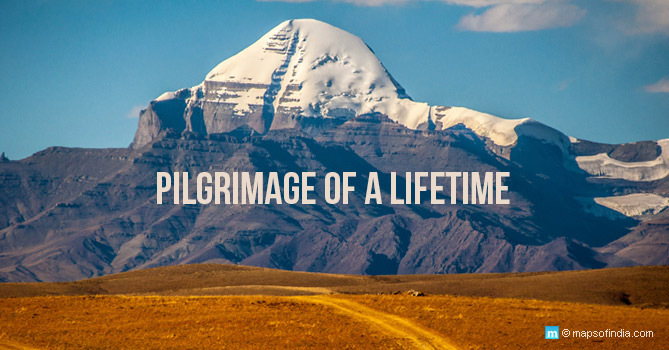A trip to Mount Kailash is one of the most arduous pilgrimages one can undertake, but it is also one of the most sacred, says Hinduism. The breathtaking beauty of the Himalayas is incentive enough; add to it the belief that this peak is the abode of God Shiva and Goddess Parvati, and we find one of the most attractive pilgrimages for Indian devotees. Mount Kailash is located in Tibet – a majestic peak of the Transhimalayan range – and quite close to the lake called Manasarovar, a very holy lake for the Hindus. A pilgrimage to Kailash and Manasarovar, generally referred to as Kailash Manasrovar Yatra, tests not only the physical fitness but also the mental strength and faith of devotees. Apart from the Hindus, the Buddhists, and Jains also consider these two places very important pilgrimage destinations.
Spiritual Centre of the World
Mount Kailash and Lake Manasarovar are at the heart of the spiritual theologies of Hinduism, Jainism, Buddhism, and in the Bon religion of Tibet. According to Hindu legends the Adi yogi, God Shiva and his consort, the Feminine Divine, Goddess Parvati reside at the summit of this peak. The peak is the pillar, the center of six mountain ranges that form the framework of the world. In some scriptures, Kailash is also called Meru, or the centre of Goddess Durga’s power.
In Jainism too, Kailash is referred to as Meru. Mount Ashtapada, next to Meru, is the peak where the first Jain Tirthankara (seer and establisher of the Jain faith) gained liberation from earthly life. According to the Buddhists of Tibet, Mount Kailash is home to Buddha Demchok – a form of the Buddha symbolizing supreme harmony and bliss. The Buddhists believe that when a number of spiritually advanced seekers undertake this pilgrimage, the Buddha manifests on the way. The Bon religion of Tibet also believes this mountain to be the spiritual centre of the world.
The Kailash Mansarovar Yatra
Despite its deep religious and spiritual significance, the Kailash Manasarovar Yatra is not an easy one to undertake. It involves trekking over 19500 feet altitude in the harshest of weather conditions and is often hazardous to those who are not physically fit. Due to its location the pilgrimage route was closed to Indians for many years. Government of India’s improving relations with the Chinese government has facilitated the conduction of the yatra in recent years. With thousands of applicants each year, the Ministry of External Affairs screens applications and shortlists applicants. The draw of lots in selecting applicants is done by a computer. The Kailash Manasarovar Yatra is conducted between June and September each year. The application needs to be done online through the Ministry of External Affairs website.
The Route through Lipulekh
After a 3-4 day stay at Delhi, yatris are sent out on the pilgrimage. After reaching Kathgodam by bus, they travel onward to Bageshwar and start the long trek after Dharchula. They halt at Gala, Budhi, Gunji, Kalapani, Navidhang and Taklakot. Porters and ponies are available for hire at Mangti. The state government of Uttar Pradesh and the Indo-Tibetan Border Police (ITBP) arrange for food, lodging, and basic medical facilities along the way.
The Circumambulation of Mount Kailash
From Taklakot each batch is split in half and each half sent to either Kailash or Manasarovar. Once the parikrama is done each half heads to the other. While some pilgrims attempt to complete the circumambulation of the Mount Kailash in a single day, others prefer to prostrate at various points and hence this takes a few days. Batches are encouraged to stick together for the entire stretch.
The trek around Mount Kailash starts from the Dolma Pass, which is at an altitude of about 19,500 feet and the air is rarified. It takes about 12 hours to trek from Darchen to Deraphuk – a 20 kilometre stretch. Gaurikund may be visited if the weather is clear. Kailash is visible to yatris from Darchen and from Ashtapad.
Manasarovar Lake
The Lake Manasarovar is a very sacred one according to Hindu mythology. It has its origins in the ‘Manas’ or thoughts of Lord Brahma, the creator, it is believed. The 85-kilometer stretch around the lake can be an intriguing one as the weather here changes very quickly. Yatris are encouraged to abstain from bathing in the Manasarovar unless the weather is bright and sunny. Pujas and rituals may be performed here.
Each batch is assigned a Liaison officer and telephone facilities and medical help is available at most major stops.
Eligibility and Costs Involved
Here is a list of the eligibility criteria for selection of Kailash Manasarovar pilgrims by the Ministry of External Affairs –
- Pilgrims applying for the yatra should be between 18 and 70 years of age and hold an Indian passport.
- Applicants should be medically fit i.e. not suffer from obesity, asthma, diabetes, high blood pressure, epilepsy, heart ailments etc. Medical test reports need to be submitted with the application and a further medical check will be undertaken once the applicant has been shortlisted.
- Applicants are advised to reduce their Body Mass Index (BMI) to 27 or less.
- Applicants will be required to arrange for trekking equipment and appropriate gear.
Number of Batches and Costs Involved
- Route 1 via Lipulekh Pass in Uttarakhand
A maximum of 18 batches with 60 members each
Total duration of yatra per batch – approximately 25 days
Approximate cost per person INR 1.5 lakh
- Route 2 via Nathu La in Sikkim
A maximum of 5 batches with 50 members each
Total duration of yatra per batch – approximately 23 days
Approximate cost per person INR 1.7 lakh
Spiritually Speaking
Despite the extreme hardships involved in the Kailash Manasarovar Yatra, hundreds undertake the pilgrimage each year. Apart from all the spiritual reasons, the breathtaking scenes and views of the Himalayas in these parts are part of the appeal. Yatris, however, need to acclimatize and to develop their fitness levels prior to the trips. Calamities enroute are not unheard of and couples often choose to travel separately for security reasons. All said, the pilgrimage is one worth undertaking once in a lifetime.






